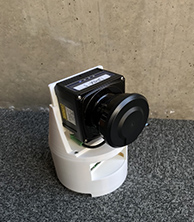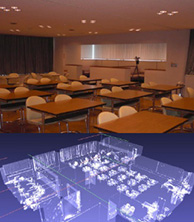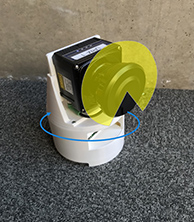Intellectual Property (IP) Strategy to Support Fujitsu's Purpose
Policy: Intellectual Property Strategy from Three Perspectives
Fujitsu’s Purpose is to make the world more sustainable by building trust in society through innovation.
The Fujitsu Uvance business brand is targeting seven Key Focus Areas as a means to achieving this purpose.
The Intellectual Property Division is building an IP portfolio centered on the key technologies that support these Key Focus Areas, and is engaged in IP activities that revolve around the following three perspectives:
- IP Strategy focused on innovation that supports the Key Focus Areas
The Intellectual Property Division builds an IP portfolio centered on Fujitsu’s five key technologies. The Division enhances IP analysis as a tool for generating innovation and leverages the Division’s well-established strengths, including its expertise in acquiring rights to the results of innovation and R&D, and strengths cultivated through frontline IP activities in fields such as open source software (OSS), IP education, etc. - IP Strategy that generates social trust
The Intellectual Property Division works to strengthen the rule-making process through activities to protect trademarks and other aspect of brands, as well as through Standards Activities to build social trust in Fujitsu technologies. - IP Strategy for a sustainable world (FUJITSU Technology Licensing Program™ for SDGs)
The ways in which Fujitsu currently leverages IP to address societal challenges include partnering with WIPO GREEN to help achieve the SDGs, providing open access to Fujitsu Group IP assets to help advance a resolution to COVID-19, and using IP to help revitalize regional Japan.

Intellectual Property Strategy to Support Fujitsu’s Purpose
Structure of the Intellectual Property Division

The Intellectual Property Division comprises the Intellectual Property Front Service Division, which is responsible for the IP support functions of the technology and business frontline, and the Intellectual Property Global Head Office, which is responsible for IP strategy and the portfolio-building function of the Fujitsu Group.
Fujitsu’s IP strategy is driven by collaboration among the Intellectual Property Innovation Center (which implements IP activities geared toward business producers and systems engineers), the IP Intelligence Service Office (which supports research institutes conducting IP research, analysis, and R&D for the business divisions), the Intellectual Property Center (which is tasked with building the IP portfolio), the Intellectual Property Strategy Office (which formulates and promotes the Group-wide IP strategy based on communication with management), and Fujitsu Techno Research Limited (which provides IP-related services).
In addition, we have developed an IP governance framework to harness the IP capabilities of the entire Fujitsu Group.

In Japan, activities of the Intellectual Property Division are carried out together with those Group companies engaged in IP activities. There are some exceptions, in which the Intellectual Property Division establishes reporting lines to, and implements closely coordinated activities with, certain companies that conduct IP activities independently.
The Division has also established global reporting lines with regional intellectual property managers(IP CoE) in Europe, China, Australia and the United States, and holds regular meetings to ensure that all IP activities conform to the realities of global business.
Initiatives
Fujitsu is building an IP portfolio centered on the key technologies that support the Key Focus Areas, and is also engaged in leveraging IP for co-creation, including collaboration to help achieve the SDGs under the FUJITSU Technology Licensing Program™ for SDGs. The Company is also engaged in using OSS, international standardization and rulemaking to establish social rules that engender trust and confidence in deploying Fujitsu’s advanced technologies, and strategic initiatives to support the Key Focus Areas from a brand and design perspective.
The following section highlights case studies of open innovation involving key technologies where particular emphasis is placed on building an IP portfolio, as well as case studies of IP activities aimed at solving societal challenges, and case studies of open innovation where IP is used for co-creation.
Open Innovation Cases
Computing: Digital Annealer (Co-creation with MELCO Investments)
Deploying the Digital Annealer architecture in stock portfolio optimization calculations
Having developed Digital Annealer (DA) as a quantum-inspired architecture dedicated to solving combinatorial optimization problems at high speed, Fujitsu is applying for numerous patents, primarily for the core technology. The Company has been conducting trials and co-creation with clients based on differentiated technologies that are supported by patents. In the area of investment in equities managed by MELCO Investments, DA was successfully used to generate portfolios comprising combinations of stocks with the lowest risk. As a result, MELCO Investments began using DA to manage financial assets in some areas of its actual portfolio management operations in January 2022.
Conventional approaches to performing optimization calculations to determine the optimal portfolio from several hundred stocks were highly impractical because they required massive computing power and a lot of time. Using Fujitsu’s DA, it is now possible to perform this task in about 10 minutes. This has enabled MELCO Investments to use analytical results, based on more accurate calculations, in their actual asset management operations.
Networking: IOWN (Strategic Business Alliance with NTT)
Joint R&D to develop next-generation 6G network technology
NTT Corporation and Fujitsu forged a strategic business alliance in April 2021 to engage in joint R&D activities toward the “realization of a sustainable digital society.” The innovation created through this alliance is designed to contribute to achieving the vision of a new low-energy, high-efficiency digital society through global, open collaboration with a wide range of partners who support the Innovative Optical and Wireless Network (IOWN) initiative.
Through this alliance, the two companies aim to conduct joint research in fields where both can leverage their strengths, backed by communications technologies such as the world's most advanced optical technologies for which NTT and Fujitsu combined hold the largest number of patents worldwide. With their operational expertise, plus Fujitsu's world-leading computing technologies, the companies aim to fulfill their shared vision through global, open innovation that leverages the results of their research.
AI: Joint Development with Subaru
Employing AI modeling to deliver quality assurance in manufacturing
Subaru Corporation and Fujitsu have been co-creating through PoCs, development, and trials since 2019, using high-precision AI modeling to deliver quality assurance in the engine component (camshaft) grinding process. As part of this collaboration, the two companies created and commercialized the industry's first AI invention to implement automated quality inspection and prediction of engine parts, and jointly applied for patents. In addition, the two companies developed and verified the “FUJITSU Manufacturing Industry Solution COLMINA Production Line Quality AI Operation and Management Package", which provides management support for the AI model in anticipation of mass production operations. The system became fully operational in February 2022. As a result, quality assurance during engine component grinding was achieved with high precision and in real time. The AI model continues to operate at an efficient level, maintaining AI model quality on an ongoing basis. Furthermore, Subaru established an AI platform to improve the level of quality assurance using real-time data throughout its Gunma Manufacturing Division, including at the Oizumi Plant.
Solving Societal Challenges: Ontenna – a Wearable User Interface that Turns Sound into Vibration

A mixed-IP strategy to support solutions to societal challenges
Ontenna is a radically new user-interface device that can be worn on the hair, earlobe, collar, cuff, etc., enabling the wearer to pick up tonal characteristics through vibration and light. It was developed in collaboration with the Deaf and the hard-of-hearing to enable a future that they can enjoy together with the hearing.
Ontenna is characterized by a gently rounded shape that does not feel unpleasant as it can be worn like a hairpin. Fujitsu has applied for and registered design patents for the main body, the battery charger, and the controller that can control multiple Ontenna devices, and has also registered the shape of the main body as a 3D trademark. Fujitsu has also applied for and registered patents for Ontenna's charging method and communication system, using a mixed-IP strategy to protect the main body and peripheral devices.
Ontenna was awarded the “Imperial Invention Prize” in the 2022 National Commendation for its design patent. It has also won several other awards including the 2019 Good Design Award “Gold Prize,” the IAUD International Design Award “Grand Prize,” and the Local Invention Award from the Commissioner of the Japan Patent Office, earning high acclaim from both inside and outside of Fujitsu.
Co-creation: FUJITSU Technology Licensing Program™ for SDGs (Haloworld)
Co-creative development of 3D Scanner "BeTHERE"
Fujitsu is promoting the brand FUJITSU Technology Licensing Program™ for SDGs, an initiative that encourages companies and academic institutions to use the Group’s intellectual property including patents and know-how as a key means of contributing to SDGs to make the world more sustainable through innovation. Fujitsu engages in collaboration via WIPO GREEN (an online platform for the exchange of environmentally friendly technologies) and IP matching programs at the national and local government levels, at financial institutions, and at universities. This contributes to the social diffusion of Fujitsu technologies to help advance a resolution to COVID-19, to conserve the environment, and to revitalize Japan’s regional economies.
One case study of IP matching is the development of the BeTHERE 3D Scanner, commercialized after robotics startup Haloworld was given a demonstration of Fujitsu's patented 3D digitizing technology prototype in 2019. This led to collaboration and the licensing of the patent to Haloworld.
BeTHERE is a 3D scanner that can capture 360-degree images at a chosen location and check the captured data on the spot. It performs texture mapping to map the captured images to 3D point cloud data where distances can be determined. With mass production in mind, Haloworld received the license to the technology for integrating (aligning) 3D point cloud data recorded multiple times from different locations. The company also upgraded the user interface to enhance operability and made additional improvements, such as dustproofing and drip-proofing, as well as improving the measurement accuracy by applying the latest LiDAR (Light Detection and Ranging) sensor to measure the distance to an object.

easy to install
WiFi remote control
Has a measurement data
transmission function

sec
Easily consolidate multiple
data points
Modeling of 3D
visualizations

directions
Distance radius: max 60 m
Up to 2,770,000
points/measuremen
[3D scanner "BeTHERE"]


